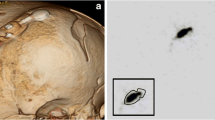Abstract
Background
Shuntograms are performed when patients present with symptoms suggestive of, but inconclusive for, shunt malfunction, without confirmatory radiological evidence.
Methods
Shuntograms over the past 3.5 years were reviewed. Patient records were reviewed for revision in proximity to a negative (normal) study.
Results
One hundred and fifteen out of 149 tests were negative. Thirty-four surgeries (in 31 patients) occurred subsequent to a negative shuntogram. In 18 out of 34 revisions the shunt was functional: 13 surgeries were for overdrainage, 4 were for unrelated reasons with shunt function confirmed incidentally and 1 was an exploration for cognitive deterioration. In 16 cases (13 patients) the shunt was not functional: 12 had proximal catheter occlusion in which, on subsequent review, there was no ventricular reflux present and the remaining had distal malfunctions.
Conclusions
The false negative rate for shuntograms was 16 out of 115 (14%) with proximal occlusion most common. This estimate of the predictive value of a normal flow study may influence the decision to revise a shunt.




Similar content being viewed by others
References
Bartynski WS, Valliappan S, Uselman JH, Spearman MP (2000) The adult radiographic shuntogram. Am J Neuroradiol 21:721–726
Brendel AJ, Wynchank S, Castel JP, Barat JL, Leccia F, Ducassou D (1983) Cerebrospinal shunt flow in adults: radionuclide quantification with emphasis on patient position. Radiology 149:815–818
Bruce DA, Weprin B (2001) The slit ventricle syndrome. Neurosurg Clin N Am 36:709–717
Cantrell P, Fraser F, Pilling D, Carty H (1993) The value of baseline CT head scans in the assessment of shunt complication in hydrocephalus. Pediatr Radiol 23:485–486
Di Chiro G, Grove AS (1966) Evaluation of surgical and spontaneous cerebrospinal fluid shunts by isotope scanning. J Neurosurg 24:743–748
French BN, Swanson, M (1981) Radionuclide-imaging shuntography for the evaluation of shunt patency. Surg Neurol 16:173–182
Garton HJ, Kestle JR, Drake JM (2001) Predicting shunt failure on the basis of clinical symptoms and signs in children. J Neurosurg 94:202–210
Graham P, Howman-Giles R, Johnson I, Besser M (1982) Evaluation of CSF shunt patency by means of technetium-99m DTPA. J Neurosurg 57:262–266
Iskandar BJ, McLaughlin C, Mapstone TB, Grabb PA, Oakes WJ (1998) Pitfalls in the diagnosis of ventricular shunt dysfunction: radiology reports and ventricular size. Pediatrics 101:1031–1036
Kan L, Nagelberg J, Maytal J (2000) Headaches in a paediatric emergency department: etiology, imaging and treatment. Headache 40:25–29
May CH, Aurisch R, Kornrumpf D, Vogel S (1999) Evaluation of shunt function in hydrocephalic patients with the radionuclide 99mTc-pertechnetate. Childs Nerv Syst 15:239–245
McComb JG (1990) Techniques for CSF diversion. Concepts Neurosurg 3:47–64
Osaka K, Yamasaki S, Hirayama A, Sato N, Ohi Y, Matsumoto S (1977) Correlation of the response of the flushing device to compression with the clinical picture in the evaluation of the functional status of the shunting system. Childs Brain 3:25–30
Pudenz RH, Foltz EL (1991) Hydrocephalus: overdrainage by ventricular shunts. A review and recommendations. Surg Neurol 35:200–212
Sainte-Rose C, Piatt JH, Renier D, Pierre-Kahn A, Hirsch JF, Hoffman HJ, Humphreys RP, Hendrick EB (1991) Mechanical complications in shunts. Pediatr Neurosurg 17:2–9
Serlo W, Heikkinen E, Saukkonen AL, Wendt LV (1985) Classification and management of the slit ventricle syndrome. Childs Nerv Syst 1:194–199
Sood S, Canady AI, Ham SD (2000) Evaluation of shunt malfunction using shunt site reservoir. Paediatr Neurosurg 32:180–186
Uvebrant P, Sixt R, Bjure J, Roos A (1992) Evaluation of cerebrospinal fluid shunt function in hydrocephalic children using99mTc-DTPA. Childs Nerv Syst 8:76–80
Vernet O, Farmer JP, Lambert R, Montes JL (1996) Radionuclide shuntogram: adjunct to manage hydrocephalic patients. J Nucl Med 37:406–410
Watkins L, Hayward R, Andar U, Harkness W (1994) The diagnosis of blocked cerebrospinal fluid shunts: a prospective study of referral to a paediatric neurosurgical unit. Childs Nerv Syst 10:87–90
Acknowledgements
Dr. O'Brien is grateful for financial assistance received from the Royal College of Surgeons in Ireland, which enabled him to travel to St. Louis Children's Hospital. J.G.O. is supported by NIH grant NS41272.
Author information
Authors and Affiliations
Corresponding author
Rights and permissions
About this article
Cite this article
O'Brien, D.F., Taylor, M., Park, T.S. et al. A critical analysis of 'normal' radionucleotide shuntograms in patients subsequently requiring surgery. Childs Nerv Syst 19, 337–341 (2003). https://doi.org/10.1007/s00381-003-0752-y
Received:
Revised:
Published:
Issue Date:
DOI: https://doi.org/10.1007/s00381-003-0752-y




